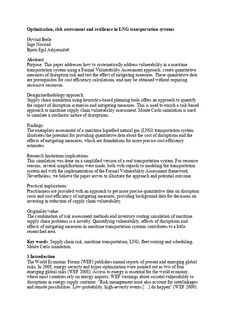| dc.contributor.author | Berle, Øyvind Foldal | |
| dc.contributor.author | Norstad, Inge | |
| dc.contributor.author | Asbjørnslett, Bjørn Egil | |
| dc.date.accessioned | 2019-05-02T12:13:00Z | |
| dc.date.available | 2019-05-02T12:13:00Z | |
| dc.date.created | 2013-04-19T15:34:31Z | |
| dc.date.issued | 2013 | |
| dc.identifier.citation | Supply chain management. 2013, 18 (3), 253-264. | nb_NO |
| dc.identifier.issn | 1359-8546 | |
| dc.identifier.uri | http://hdl.handle.net/11250/2596325 | |
| dc.description.abstract | Purpose
– This paper aims to address how to systematically address vulnerability in a maritime transportation system using a formal vulnerability assessment approach, create quantitative measures of disruption risk and test the effect of mitigating measures. These quantitative data are prerequisites for cost efficiency calculations, and may be obtained without requiring excessive resources.
Design/methodology/approach
– Supply chain simulation using heuristics‐based planning tools offers an approach to quantify the impact of disruption scenarios and mitigating measures. This is used to enrich a risk‐based approach to maritime supply chain vulnerability assessment. Monte Carlo simulation is used to simulate a stochastic nature of disruptions.
Findings
– The exemplary assessment of a maritime liquefied natural gas (LNG) transportation system illustrates the potential for providing quantitative data about the cost of disruptions and the effects of mitigating measures, which are foundations for more precise cost efficiency estimates.
Research limitations/implications
– This simulation was done on a simplified version of a real transportation system. For resource reasons, several simplifications were made, both with regards to modeling the transportation system and with the implementation of the formal vulnerability assessment framework. Nevertheless, the authors believe the paper serves to illustrate the approach and potential outcome.
Practical implications
– Practitioners are provided with an approach to get more precise quantitative data on disruption costs and cost/efficiency of mitigating measures, providing background data for decisions on investing in reduction of supply chain vulnerability.
Originality/value
– The combination of risk assessment methods and inventory routing simulation of maritime supply chain problems is a novelty. Quantifying vulnerability, effects of disruptions and effects of mitigating measures in maritime transportation systems contributes to a little‐researched area. | nb_NO |
| dc.language.iso | eng | nb_NO |
| dc.publisher | Emerald | nb_NO |
| dc.title | Optimization, risk and resilience in LNG transportation systems | nb_NO |
| dc.type | Journal article | nb_NO |
| dc.type | Peer reviewed | nb_NO |
| dc.description.version | acceptedVersion | nb_NO |
| dc.source.pagenumber | 253-264 | nb_NO |
| dc.source.volume | 18 | nb_NO |
| dc.source.journal | Supply chain management | nb_NO |
| dc.source.issue | 3 | nb_NO |
| dc.identifier.doi | 10.1108/SCM-03-2012-0109 | |
| dc.identifier.cristin | 1024724 | |
| dc.description.localcode | © 20xx. This is the authors' accepted and refereed manuscript to the article. The final authenticated version is available online at: https://doi.org/10.1108/SCM-03-2012-0109 | nb_NO |
| cristin.unitcode | 194,64,20,0 | |
| cristin.unitcode | 194,60,25,0 | |
| cristin.unitname | Institutt for marin teknikk | |
| cristin.unitname | Institutt for industriell økonomi og teknologiledelse | |
| cristin.ispublished | true | |
| cristin.fulltext | preprint | |
| cristin.qualitycode | 1 | |
